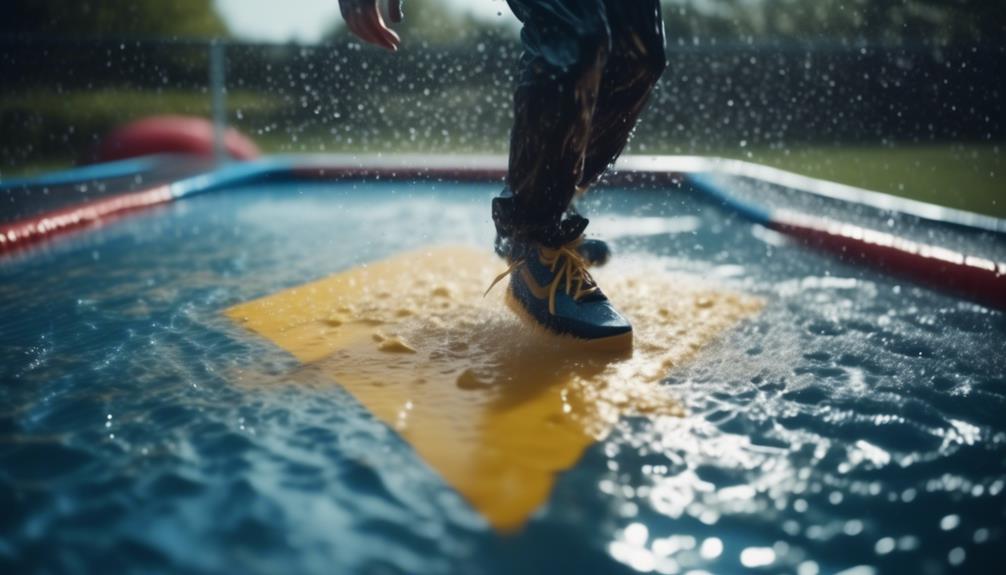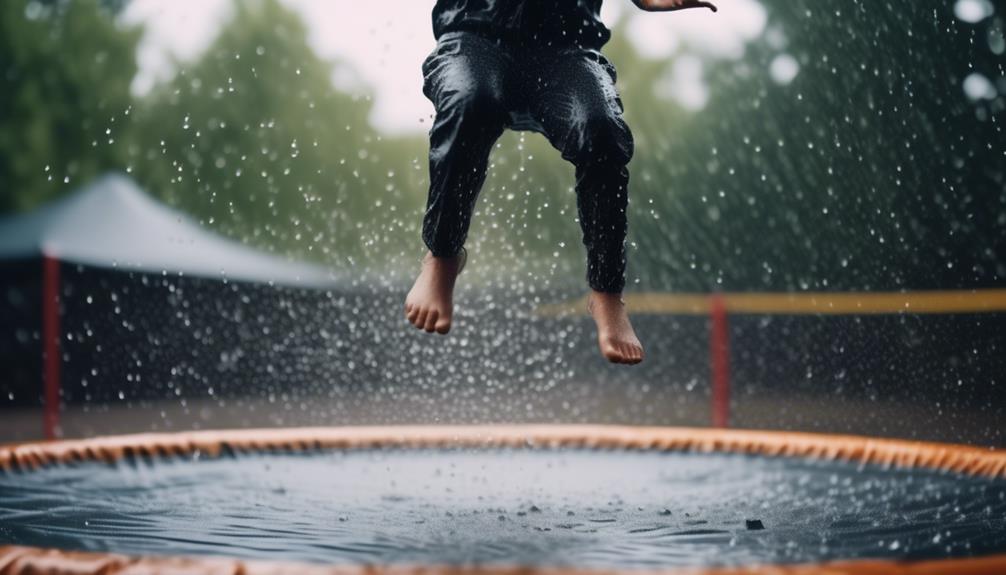Is It Safe to Jump on a Wet Trampoline
This post contains affiliate links. As an Amazon Associate, we earn from qualifying purchases.
Jumping on a wet trampoline raises concerns about safety, particularly regarding the increased risk of slips and falls. The potential hazards associated with wet surfaces and the inherent bounce of trampolines warrant a closer examination of the safety considerations.
It's important to understand the implications of moisture on trampoline surfaces and the measures that can be taken to mitigate the associated risks.
With this in mind, it's crucial to explore the various factors that influence the safety of jumping on a wet trampoline, and how best to navigate these concerns to ensure a safe and enjoyable experience for trampoline enthusiasts.
Key Takeaways
- Wet trampoline surfaces can be slippery, increasing the risk of accidents and collisions.
- Installing a safety net and using non-slip mats or grip socks can enhance safety on wet trampolines.
- Regular maintenance and inspection are necessary to prevent damage from UV rays and ensure the trampoline's integrity.
- Close supervision and setting ground rules for usage, such as only allowing one person to jump at a time, can minimize accidents on wet trampolines.
Wet Trampoline Safety Considerations
Wet trampoline safety considerations encompass a range of measures to mitigate the increased risks associated with jumping on a wet surface. The presence of water on the trampoline can make it more slippery, thus increasing the likelihood of accidents and collisions during use.
It's important to consider weather conditions and the exposure to water when allowing individuals to use the wet trampoline. Installing a safety net can reduce the chance of slipping off the trampoline, especially for younger children.
Additionally, ensuring the trampoline is in good condition, with a sturdy metal frame and a weight limit that is not exceeded, is crucial for safety. Exposure to UV rays can impact the trampoline's materials, so regular maintenance and inspection are necessary.
Implementing ground rules for usage, such as using a non-slip mat or grip socks and avoiding high-risk tricks, also enhances safety on a wet trampoline.
Risks of Jumping on Wet Trampoline

Jumping on a damp trampoline poses heightened safety risks due to the increased slipperiness of the surface, potentially leading to a greater likelihood of accidents and loss of control during use. The wet surface reduces traction, making it easier to slip and fall, increasing the risk of collisions and injuries.
Additionally, jumping on a wet trampoline can lead to less control of directions and wipeouts, resulting in injuries. The excess water on the trampoline mat adds weight, potentially affecting the trampoline's integrity and bounce height. Moreover, the moisture can lead to rusting in the springs, causing damage and reducing the trampoline's lifespan.
Therefore, it is essential to exercise caution and consider safety measures, such as installing a safety net and setting guidelines for usage on wet trampolines to mitigate these risks.
Tips for Trampoline Safety in Wet Conditions
When using a trampoline in wet conditions, it is essential to prioritize safety by implementing specific measures to mitigate the increased risks associated with the slippery surface. Consider wiping the wet trampoline surface before use to reduce slipperiness. Install a safety net to prevent collisions and provide additional safety when jumping. Avoid jumping with friends on a wet trampoline to reduce the risk of collisions and loss of control. Set ground rules for usage and consider using a non-slip mat or grip socks to improve traction on the wet surface.
Supervise closely and ensure only one person jumps at a time to minimize the risk of accidents. Additionally, protect your trampoline from wet weather by investing in a quality trampoline cover and ensuring proper care and maintenance of the frame and springs.
Maintaining Your Trampoline After Rain

After a rainy day, it is crucial to ensure proper maintenance of your trampoline to prevent potential damage and ensure continued safety for users.
After the rain has subsided, make sure to thoroughly inspect the trampoline for any accumulated water or pooling. Clear the trampoline of any debris and use a towel to dry any remaining moisture to ensure it is safe to use.
Pay close attention to metal parts for any signs of rust, as constant exposure to water can expedite rusting. Additionally, ensure that the trampoline's weight capacity has not been exceeded due to the added weight of the water.
Wet Trampoline Bouncing Impact
Following the necessary maintenance and inspection after rainfall, the impact of wet trampoline bouncing on safety and equipment durability is a significant consideration for users. When it comes to wet trampolines, the following points should be considered:
- Safety First
- Wet trampolines are more slippery, increasing the risk of accidents and collisions.
- Guidelines should be set for usage of wet trampolines to prevent accidents, especially for younger children.
- Equipment Durability
- Wet trampoline usage can accelerate corrosion of metal parts and wear out the jumping mat, requiring regular maintenance.
It's crucial to closely supervise kids and adults bouncing on a wet trampoline, especially during pool parties or wet weather, to ensure safety and prevent accidents. Installing safety nets and using non-slip mats or grip socks can enhance traction on wet trampoline surfaces.
Frequently Asked Questions
Can You Jump on a Trampoline While It's Wet?
Jumping on a wet trampoline poses a slip and fall risk due to reduced traction. Wet surfaces can also compromise the trampoline's structural integrity, increasing the likelihood of accidents. It's advisable to wait until the trampoline is dry before use.
Does Water Damage Trampolines?
Water exposure can lead to rust on trampoline springs, necessitating regular maintenance to prevent damage. It's important to consider the implications on homeowners' insurance coverage, as trampolines can increase costs and liability for related accidents.
What to Do With Trampoline When It Rains?
When it rains, it's advisable to cover the trampoline with a waterproof trampoline cover. Regularly maintain the trampoline to prevent water damage. Consider alternative indoor activities during rainy days to avoid using a wet trampoline.
Does Wetting a Trampoline Make It Bouncier?
Wetting a trampoline may give a temporary perception of increased bounce due to reduced friction between the jumping mat and the feet. However, this can also lead to a higher risk of slipping, resulting in accidents.
Conclusion
In conclusion, jumping on a wet trampoline poses safety risks due to the increased slipperiness of the jumping pad and other surfaces.
It is important to establish ground rules, such as allowing only one person to jump at a time, and to avoid acrobatics and excessive bounce height to prevent dangerous landings.
Close supervision and maintenance of the trampoline after rain are essential for mitigating the risks associated with wet trampoline jumping.
